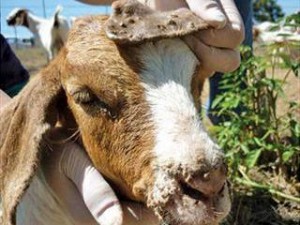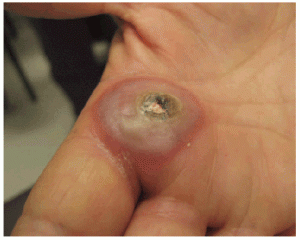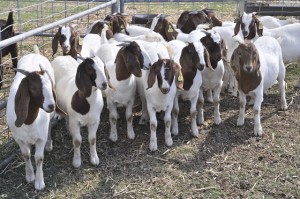Goat Diseases
Orf Virus in Goats
Orf is a global pathogen which causes significant financial losses in livestock production as the lesions often jeopardise optimum productivity, and reduce the market value of meat. Severe lesions can interfere with feeding, or if the teats and/or udder are infected, it may lead to abandonment of offspring (Nandi et al., 2011).
Control and Prevention
Vaccination Options
Treatment Options
Orf and Public Health
Good Practice
Clinical Signs of Orf

Orf infection on a goat in South Africa. The scabby lesions on the nose, mouth and ears are fairly typical of Orf infection. This image is from www.farmersweekly.co.za
Orf virus transmission occurs through direct contact, entering through damaged skin. The virus replicates in the surrounding skin cells causing typical characteristic lesions. Approximately a week after the initial infection, kids usually have a raised temperature followed by the development of spots, pustules and scabs at the infection site which is often the mouth, lips and nose area. Lesions can also be seen on the tongue, gums and palate (McElroy and Bassett, 2007). Younger animals (<2 months) are most susceptible and the infection can extend of the face, feet, flanks, scrotum and peri-anal area. The development pattern takes place in a period of about 2 months (Nandi et al., 2011). In most cases orf is a benign, self-limiting disease and can cure itself in a few months, however in very young animals it can be persistent and even fatal (Spyrou and Valiakos, 2015).
Other diseases that cause pustular lesions on the mouth include foot and mouth disease, blue-tongue disease, pox, mange and bacterial dermatitis.
Orf can be spread from the mouth of young kids to the teats of does, predisposing the animals to mastitis (Mavrogianni and Fthenakis, 2007). In adult animals lesions can also be found on the genitals. This venereal infection can lead to the inability of adults to copulate (Spyrou and Valiakos, 2015).
Secondary bacterial infections and Orf
Secondary bacterial infections are not uncommon and usually involve staphylococci, streptococci, Fusobacterium, cornyebacterium and less often dermatophilius (Spyrou and Valiakos, 2015). In some affected animals the condition is aggravated by flies.
Control and Prevention of Orf in Goats
The orf virus can survive in dry environments for many years (Spyrou and Valiakos, 2015). It is likely that the virus can persist in buildings and on handling equipment, therefore good farm hygiene is important. All housing and equipment should be thoroughly cleaned and disinfected between groups. When possible young stock should be housed away from contaminated buildings.
Vaccinating against Orf
If orf is a problem then vaccination is possible to reduce the severity of the disease. Orf vaccine contains live virus so must be administered with extra care. It is important that vaccinated animals do not come into contact with unvaccinated animals for at least 7 days, and the vaccine should NEVER be used on farms with no previous cases of orf (see box).
There is only partial immunity following clinical disease or vaccination, recurrent infections can occur in 1 – 3 months but are usually less severe and heal rapidly (Nandi et al., 2011)
Treatment of Orf in Goats
There is no treatment available for orf as it is a primary viral infection. However treatment with local antiseptics and pain relief can be helpful for secondary infections. Every animal with clinical signs should be kept and fed separately from symptom free animals. Supportive treatment for young animals who are unable to feed well should be undertaken (Nandi et al., 2011).
Few traditional herbal therapies have been attempted in orf virus infection including plant oils from sesame, juice from Euphorbia spp., and in France and the Netherlands common holly plant (Ilex aquifolium) is used for curing and preventing orf (Nandi et al., 2011).

Orf virus is zoonotic. Gloves and a mask should be worn when handling goats with of lesions. This image is from the Centre for Disease Control (CDC) website www.tinyurl.com/cdc-orf-hand
Orf and Public Health
Human orf lesions generally appear on fingers, hands or forearms, after a three to seven day incubation period. Most infections are self-limiting, resolving in about four to eight weeks. Treatment consists of basic wound care. Protective immunity is incomplete, so people can become infected multiple times (Ganter, 2015).
Due to the zoonotic nature of this virus, people who come into contact with infected animals should wear protective gloves and a mask. They should be careful to avoid any contact of abraded skin with infected animals (Nandi et al., 2011; Spyrou and Valiakos, 2015).
Good Practice Based on Current Knowledge
- Maintain a closed herd
- Quarantine any new animals and observe closely for any signs of infection
- Do not vaccinate unless orf is a reoccurring problem on your farm
- Separate any infected animals and ensure they can feed effectively, assist if necessary
- Lesions may become susceptible to secondary bacterial invasion, so treat with antiseptics if necessary


 American English
American English


Comments are closed.